Schnellbomber company Dornier
The restoration of the German air force, which began in the 1930s, was based on a concept that included the dominance of bomber aircraft. In the summer of 1935, a plan was introduced that provided for the production of 3820 combat aircraft, including 1849 bombers.
The question of what kind of cars should make the impact power of the Luftwaffe, was also resolved. Several concepts of bombers were chosen, the most promising of which was a twin-engine high-speed aircraft with minimal defensive armament - the Schnellbomber ("Schnellbomber"). It was these machines that were actively promoted in the German press, which at the same time mercilessly criticized the heavy "flying fortresses" created in Great Britain and other countries. The Ministry of Propaganda stressed that the main “consumer quality” of German structures is high speed, which perfectly compensates for modest defensive capabilities. The Schnellbomber concept, to one degree or another, fitted new Luftwaffe bombers He 111 and Ju.86 at that time. However, it was fully embodied in the aircraft Do.17. It was the Dornier bomber that showed amazing results in tests and competitions. German propaganda praised Do.17 as an aircraft that has no analogues in the world. But first things first.
Dornier Metallbauten was widely known in the twenties as a manufacturer of large flying boats, which gained recognition on all continents and were produced in a number of countries. Perhaps only Junkers could claim greater success in the revival of the German aircraft industry after the defeat in the First World War. With the advent of Hitler to power, the company expressed interest in land vehicles.
The main character of the German propaganda films was then the Dornier plane - Do.11 - the first fascist air force bomber. And soon rumors leaked from the company about the existence of an even faster high-level bomber, supposedly even faster than existing fighters at that time. Sensation erupted - in 1937 at the Alpine Circle combat aircraft races in Switzerland. A graceful bomber, immediately nicknamed for its thin profile “Flying Pencil”, went around all the planes, including fighters. The bomber showed a speed of 456 km / h - 40 km / h higher than the then best western interceptor "Devatin" D.510. This demonstration raised aviation Germany’s prestige, but it also had a large share of propaganda.
Speaking about the creation of Do.17, it is often mentioned that it was originally disguised as a civilian aircraft, like Non-111 and Ju-86. But the truth was that initially this aircraft was designed specifically as a civilian, and its transformation into a bomber was a pure coincidence.
For its European express service, Lufthansa Airlines ordered a high-speed mail plane, which was supposed to carry mail and six passengers. Dornier designed the aircraft for the strongest German engines - VMW-VI (take-off power 660 hp) using the latest achievements of aerodynamics - the concept of a free-bearing, all-metal monoplane with the main landing gear removed in flight. The tail stand was also removed. The two-spar wing had both metal and canvas lining - the latter was stretched between the side members on the bottom surface. The plumage was one chin. The fuel was located in the centering tanks between the side members.
The first experienced Do.17V1 took off in the autumn of 1934, and by the end of the year two more were ready - Do.17V2 and V3. Despite the fact that, according to flight data, the aircraft fully complied with the requirements put forward by Lufthansa, the airline concluded that Do.17 is not suitable for practical use due to insufficient passenger capacity. The narrow fuselage contained only two extremely cramped cabs. Passengers needed to perform the wonders of acrobatics in order to get into these little rooms. The airline decided not to risk its prestige and returned the aircraft.
All work on Do.17 was stopped, and the aircraft returned to the hangar in Leventhal. There might have ended them storyif not an occasional visit by a former employee of Dornier, the flug-captain Untiht. One of the most famous pilots of Lufthansa, who became famous in 1933 for eight records on He.70, also served as a communications officer in the Reich Aviation Ministry. Having flown around one of Do.17, Untycht made a proposal to turn it into a bomber, which did not arouse enthusiasm in the company.
To understand how the bomber was represented there, just look at the angular Do.23 - the development of the not very successful Do.11.
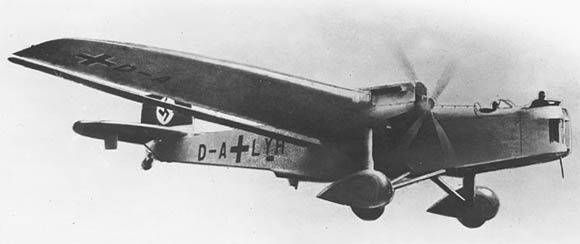
But by the time the Ministry of Aviation had developed the concept of a high-speed bomber capable of operating without fighter cover. The military considered Untiht’s proposal acceptable and lowered Dornier’s order for the manufacture of a military vehicle with minimal improvements compared to its civilian counterpart. The aircraft differed only in replacing passenger cabins in the bomb bay and installing two-tail fin to increase stability on the combat course.
So in the middle of 1935, Do.17V4 appeared. Compared to transport options, it has become shorter - from 17,7 to 17,15 m. But the VMW-VI motors have been preserved. The next experienced Do.17V5, completed in two months, was equipped with two water-cooled Hispano-Suiza -12Ybrs hn XXXX motors. near the ground and 775 hp at an altitude of 858 m. With such a power plant, the aircraft has developed a speed of 4000 km / h - more than all the biplane fighters.
Do.17 did go away from any Luftwaffe fighter, but still did not dare to leave the plane without defensive weapons. The next prototype Do.17V7 has already received defensive armament, but only from one 7,9-mm MG 15 machine gun in a blister on the top of the fuselage. This prototype also received a rounded, glazed nose. Do.17V9, which appeared in March 1936, differed even less in length of the fuselage and received full glazing of the scorer cabin. This aircraft and became the benchmark for the series.
Preparation for mass production began at once in three Dornier factories in 1936. The first serial modifications were the bomber Do.17-1 and the long-range reconnaissance Do.17F-1. Produced in parallel, these options were almost identical. The scout was not only equipped with a bomb-sight and a mechanism for dropping bombs, but an additional fuel tank and a pair of cameras were mounted in its fuselage. Defensive armament was soon supplemented by the installation of the lower hatch MG 15. The third machine gun installed in the front glazing of the cockpit. The Do.17Е-1 bomb bay contained up to halftones of bombs, and for close distances the bomb load could be 750 kg.
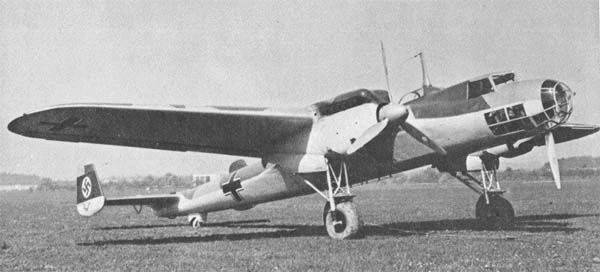
Do.17 was not only the implementation of a new concept of a bomber, but also a touchstone for the German aviation industry. Its launch in the series became a model for all subsequent mass production programs. The company broke the plane into a number of individual nodes, simplifying the work of subcontractors. Significantly facilitated and repairs in the field. For the first time, extensive cooperation with non-aviation firms was used for production.
Despite temporary difficulties, the pace of production grew very quickly. This made it possible in the spring of 1937 to send the first unit from the X. NUMX reconnaissance system Do.15F-17 to Spain - a real “testing ground” for running in new theories of air warfare. In the Condor Legion, Do.1 was replaced by the scouts He.17. Dornier airplanes easily escaped from most Republican fighters. This made such an impression on the Luftwaffe that it was decided to urgently re-equip all long-range reconnaissance squadrons from He.70 to Do.70.
Soon X. NUMX Do.20-17 bombers with German crews appeared in Spain, and then 1 Do.10F bombers. At first, they also acted with impunity, but with the strengthening of republican aviation by modern fighters (first of all - I-17), the situation changed drastically. As a result, Do.16 was handed over to the Francoists, who used them under the nickname “Bacallaos” (“cod”). By the end of the war, the Phalangists had only 17 Do.13E F. left.
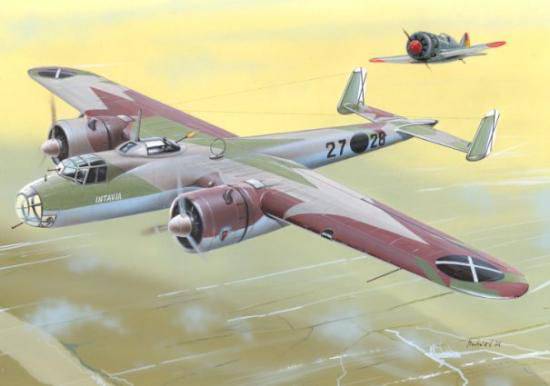
The main drawback of the machines of the early series was the use of an already outdated engine, but the design of the aircraft was very successful - it made it easy to install both air and liquid cooling engines. Even before the first serial production of the Do.17, the Dornier began to modernize the base model. That is how Do.17V8, also known as Do.17МV1, appeared, which made so much noise during the races in Switzerland.
The plane was made under the engines "Daimler-Benz" DВ 600А with take-off power in 1000 hp and it is completed with three-blade screws of a changeable step. In addition, his aerodynamics improved markedly, which allowed him to splurge in Zurich. There would have been less enthusiastic feedback, know in the West that production aircraft coming in the Luftwaffe flew slower on 80 km / h.
And the new variant did not go to the series - priorities were changed again, and powerful engines were needed for Messerschmitt fighters. I had to choose the Bramo-323-1 "Fafnir" - 9-cylinder, star-shaped, HP 1000 power. The plane extended the bomb bay, which raised the combat bomb load to 1 t. All this allowed to begin mass production at the end of the 1937 bomber Do.17М-1, which was also produced in tropical design, and for operations over the sea could be carried in the bomb bay and lifeboat.
But the efficiency of the engine was low - the plane was no longer suitable for the role of a long-range intelligence officer. Therefore, for the special reconnaissance version Do.17Р, the Wright Cyclone license, which was less powerful but more economical, had to be used. A pair of Rb 50 / 30 or 75 / 30 cameras was placed in the bomb bay. Do.17М and Р were not long in service with the Luftwaffe — by the beginning of the war, they had been replaced by regular bomber modifications.
But the "Zurich" aircraft served as a prototype for one more option - Do.17K. The races made such a strong impression on the Yugoslav Air Force that they immediately obtained from their government the decision to launch the production of such a successful car. 20 copies purchased in Germany, the rest were built under license. The main difference between the Yugoslav variant was the use of the “Gnome-Ron” engines. There is also an elongated nose, modeled on Do.17V8.
The aircraft was produced in Yugoslavia in three versions: Do.17КЬ-1 - a bomber, and two scouts: Do.17Ка-2 and Do.17Ка-3. Intelligence options differed photographic equipment - Ka-2 was a pure intelligence officer, and Ka-3 could be used as a bomber.
The maximum speed of Do.17K was 350 km / h near the ground and 412 km / h at an altitude of 3500 m. The range of the reconnaissance flight was - 2400 km. The bomber Do.17KK-1 could carry up to one ton of bombs. The defensive small arms included an 20-mm Cannon Hisu-Suiza and a 7,92-mm Browning machine gun in the nose of the aircraft, and two 7,92-mm Browns in the hatch and upper settings.
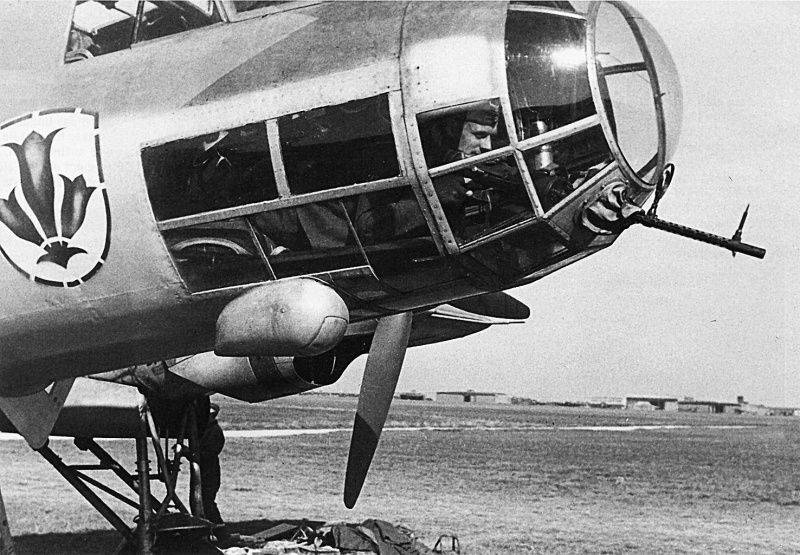
When Germany invaded the territory of Yugoslavia in the spring of 1941, the latter was armed with 70 Do.17K, which constituted the 3rd aviation regiment. During the first strike, the Luftwaffe was able to destroy 26 cars at airfields. However, the rest bombed Sofia and other targets in Bulgaria, as well as stormed the German Tanks and military columns. Only a few Yugoslav Do.17K remained in flight condition. On April 19, two of them loaded with gold flew to the British. The remaining planes captured by the Nazis at the airfields were carefully restored and handed over to the Croatian Air Force in the winter of 1942. The latter used them against the Yugoslav partisans.
Using the experience of the war in Spain, Dornier engineers at the beginning of 1938 developed a new nose, which fully met the requirements of combat use, albeit to the detriment of aerodynamic cleanliness. In fact, the new cabin became a model for all subsequent Luftwaffe bombers - it allowed the entire crew, up to four people, to be placed in a tight but not close arrangement, providing mutual support for each other. Considerably the review improved, angles of firing of the lower machine gun increased. The bomber itself became a visual reflection of the views of the Luftwaffe, which required the creation of universal, twin-engine combat vehicles with increased wing loading.
The new nose section and the expansion of the equipment required the use of more powerful engines, but the Do.17Z bomber variants under the Daimler-Benz engines DB-600 did not become popular due to the lack of these engines. As a result, Do.1938Z-17 appeared in 1. It differed from the Do.17M only in the nasal section, so the flight characteristics remained almost unchanged. But the insufficient engine power made it necessary to reduce the maximum bomb load to 500 kg.
Only the installation in 1939 of the Do.17Z-2 of the more powerful Bramo Vgato-323P engines allowed to increase the load to one ton again, but with a reduced fuel reserve. The range does not exceed 330 km. The reconnaissance bomber Do.17Z-3 was also manufactured in small quantities with a Rb 20 / 30 camera and a bomb load of up to 500 kg. In the maintenance parts of the Luftwaffe, some of the vehicles were converted into dual-control Do.17Z-4. Do.17Z-5 was packaged with inflatable "bags" that provided floodability. A total of five hundred Do.17Z-1 and Z-2 and twenty-two Do.17Z-3 were released.
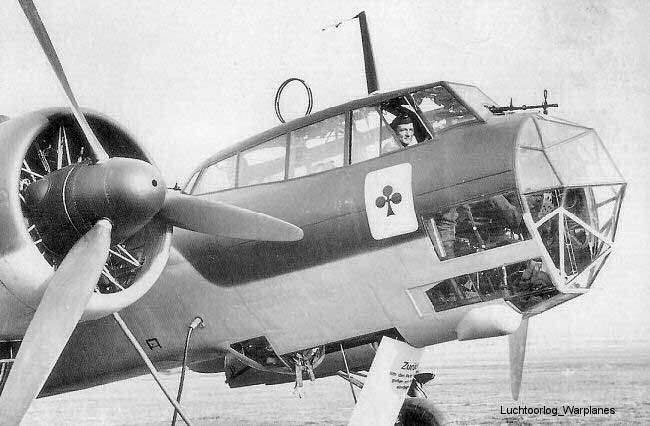
By the beginning of the Second World War, the Do.17 was almost completely replaced in the bombing parts of the previous series of aircraft. A total of 9 bomber and 23 reconnaissance air groups included 632 Do.17, of which 554 was considered as combat-ready, these were mostly Do.17Z (212) bombers.
Almost the entire Do.17 park participated in the Polish campaign. They dropped the first bombs over the “Polish corridor” within 45 minutes after the declaration of war. Do.17 squadrons did not take part in the Norwegian operation in the spring of 1940, but all of them were actively used during the invasion of France. It was the combat operations of the Do.17Z-2 from the 2 bomber squadron to “clean up” the English Channel from English ships that became the prelude to the “battle for England”.
Combat experience showed that the Dornier aircraft was in this battle, perhaps the most effective Luftwaffe bomber. With good maneuverability, he could reach speeds up to 600 km / h in a gentle dive. To achieve the effect of surprise, the planes reached the target using the minimum altitude. But over Britain rather quickly revealed the weakness of defensive weapons. As a result, parts of the technical support were added to the aircraft on two side 7,9-mm MG 15 machine guns, the shooting of which was conducted by a radio operator. Technically, the Do.17 was considered the most reliable German bomber, which gained popularity among its crews and ground personnel.
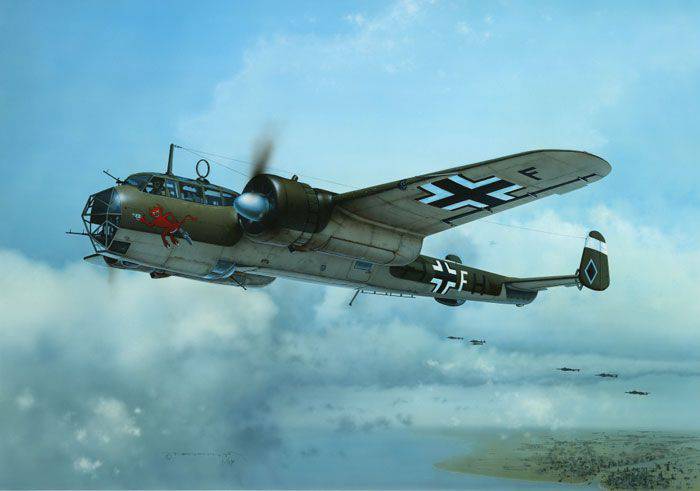
But the “battle for England” turned out to be the beginning of the end of a career in Do.17. The plane was inferior to He.111 in range and bomb load, and the new Junkers Ju.88 was also in speed. The latter became a substitute for the Dornier bomber in combat and reconnaissance squadrons. Only in the 2-th bomber squadron decided to keep the "seventeenth" in anticipation of the rearmament of the new Do.217. This squadron participated in the Balkan campaign and in the attack on our country, being there the only one flying to Do.17. But in November, 1941, it was withdrawn from the front for rearmament. The few remaining aircraft were transmitted to the satellites of Germany. Thus, a squadron of Croatian fascists participated in Do.17Z in the battle of Moscow, but, having lost six crews, was also withdrawn from the front. 15 Do.17Z in April 1942 Goring "presented" to the Finns. By the beginning of the July offensive of the Red Army in 1944, there were still five serviceable vehicles.
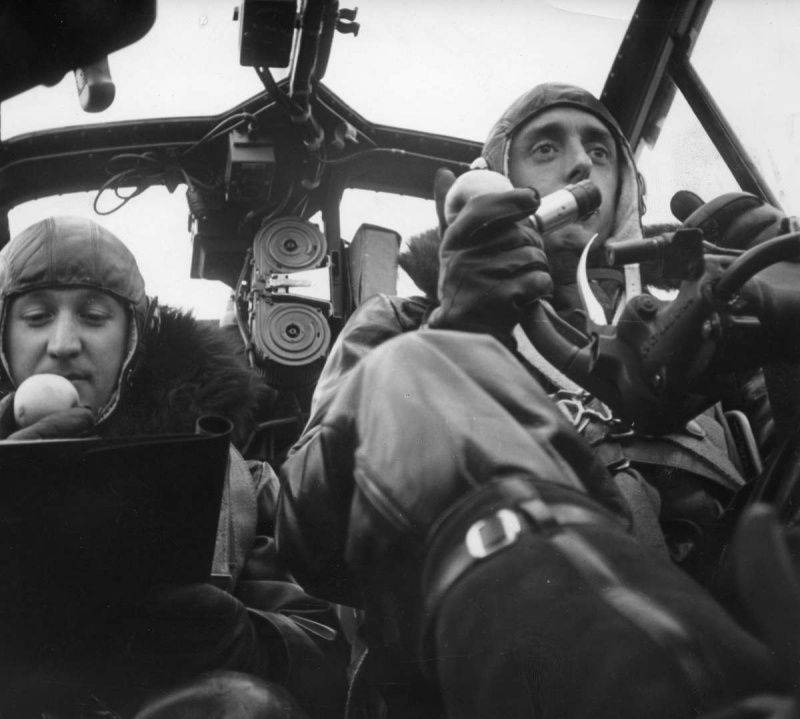
With the complete withdrawal of Do.17 from the Luftwaffe bomber units, Dornier received a new role - glider towers. In this capacity, they served to the end of the war.
A completely outdated bomber served as the beginning of a whole series of night fighters. Moreover, the tasks that were set for him were not defensive, but offensive. In preparation for the invasion of the British Isles, the command of the Luftwaffe developed the concept of a long-distance night “hunter” capable of blocking British airfields in the dark. From such an aircraft was required, first of all, a long range and duration of flight. The speed with the attack of landing aircraft did not play a decisive role.
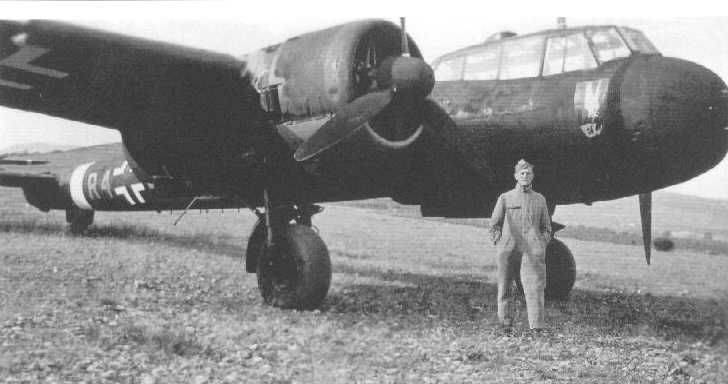
The first version of the night hunter Do.17Z-6, called “Kauts” (“Sych”), was created based on Do.17Z-3 and differed only in the bow section taken from Ju.88С-2 and having an 11-mm armored partition. The fixed weaponry consisted of three 7,9-mm MG 17 machine guns and one 20-mm MG FF cannon. The crew was reduced to three people: a pilot, a radio operator and a flight engineer. The front bomb bay occupied the 900-liter fuel tank.
After the release of one, the Do.17Z-6 designed the new nose of the fuselage. The following nine cars were built in the Do.17Z-10 or Kauz version - N. The new nose of the aircraft was more aerodynamic and contained four MG 17 and two MG FF. A heat finder was located ahead. It provided detection of hot exhaust gases flying ahead of the aircraft. The data of the direction finder was displayed on a small screen mounted behind the left side of the frontal glazing. It was impossible to distinguish one's aircraft from an enemy using this device, and the pilot himself had to decide whether to attack the detected object.
Sychy joined the 1 group of night fighters. One of them won 19 on October 1940, the group’s first night victory. Chief Lieutenant Ludwig Becker intercepted Wellington with a heat finder. The Do.17Z-10 pilots worked out the attack technique of the British bombers who were on the waiting circle before landing. Several British cars were shot down, but indirect losses were even greater - many bombers crashed during hasty landing of pilots who were trying to shorten the waiting time on the landing circle as much as possible. Success in the defense of their cities was much more modest - the lack of the necessary means of early detection of the enemy at night affected.
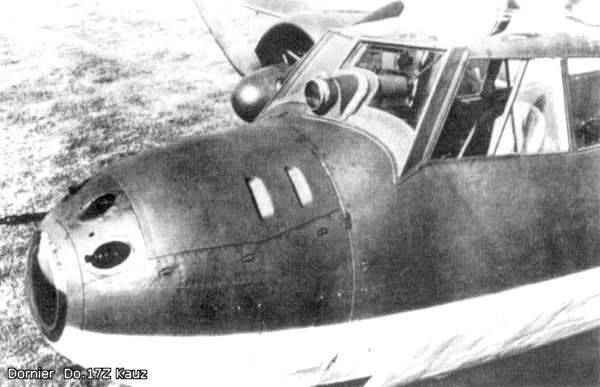
Sychi continued raids to the bases of the British bombers until mid-October 1941, when Lieutenant Hans Gahn, the famous night ace, did not return from a combat mission. All night raids were banned by Hitler’s personal directive. In the first months of 1942, the "Kautsy" finally removed from combat units.
Despite the fact that Do.17 at the beginning of his journey was able to overshadow all the bombers created according to the “Schnellbomber” concept, he did not become a “long-liver”. Of the three types created in the mid-thirties, only He.111 managed to hold out in combat units throughout the Second World War. Another peer, Ju.86, was not very successful. However, Junkers engineers were able to develop the Ju.88 in a timely manner. This bomber managed to oust not only Do.17 from combat units, but even the new Do.217 created to replace it. Although it should be said that intrigues in the top leadership of the Luftwaffe played a certain role in this.
Bombers and scouts Do.17, and in particular its late modifications, enjoyed, as already mentioned, the popularity of flight and ground personnel. This aircraft was considered the most reliable twin-engine machine in the Luftwaffe. However, to continue his career, he did not have enough payload He.111 and speed Ju.88.
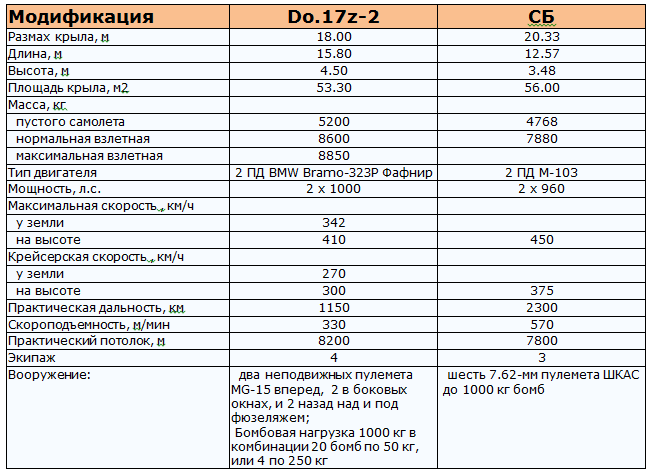
Sources:
Haruk A. "Flying Pencil". Airplane "Dornier" Do.17 // Aviation and time. 2012. No.2. C. 4-35.
Bakursky V. Dornier Do.17 // Aviation and Cosmonautics. 1996. No.11-12. C. 52-62.
Kotelnikov V. In the air "Sychi" // Aviation and Cosmonautics. 1999. No.7. C. 40-41.
Firsov A. "Flying Pencil". Bomber Dornier Do-17 // Wings of the Motherland. 1995. No.6. C. 20-22.
William Green. Wings of the Luftwaffe (warplanes of the Third Reich). Part of 1. M .: Publishing Department TsAGI, 1994. C. 65-72.
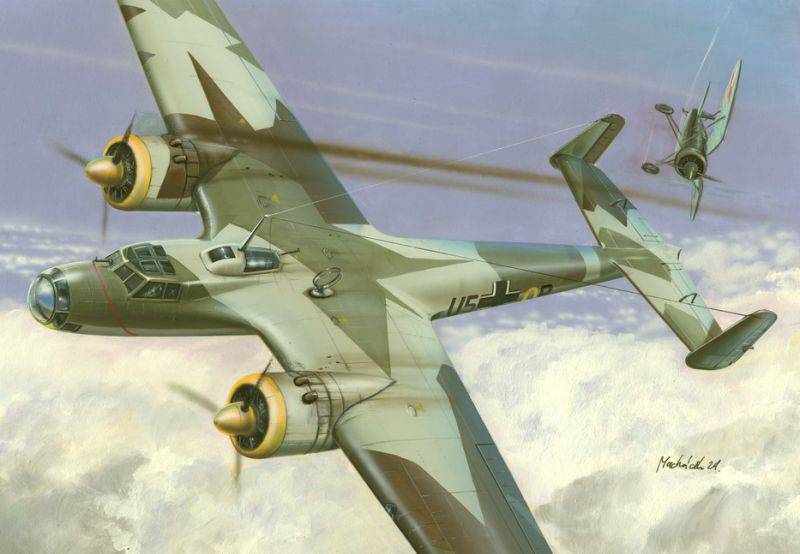
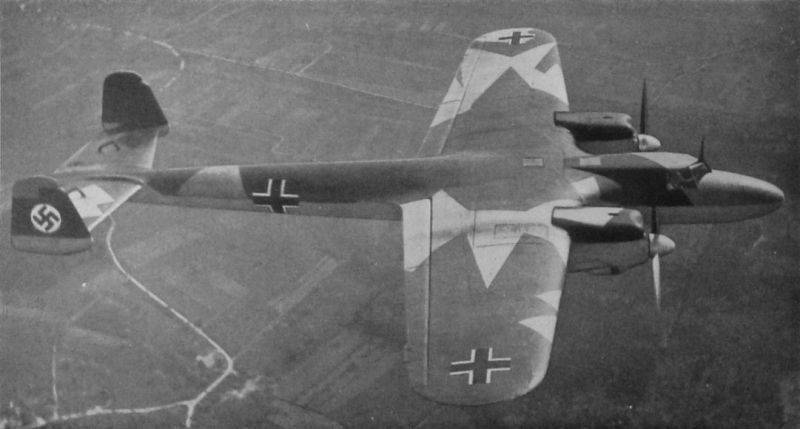
Information